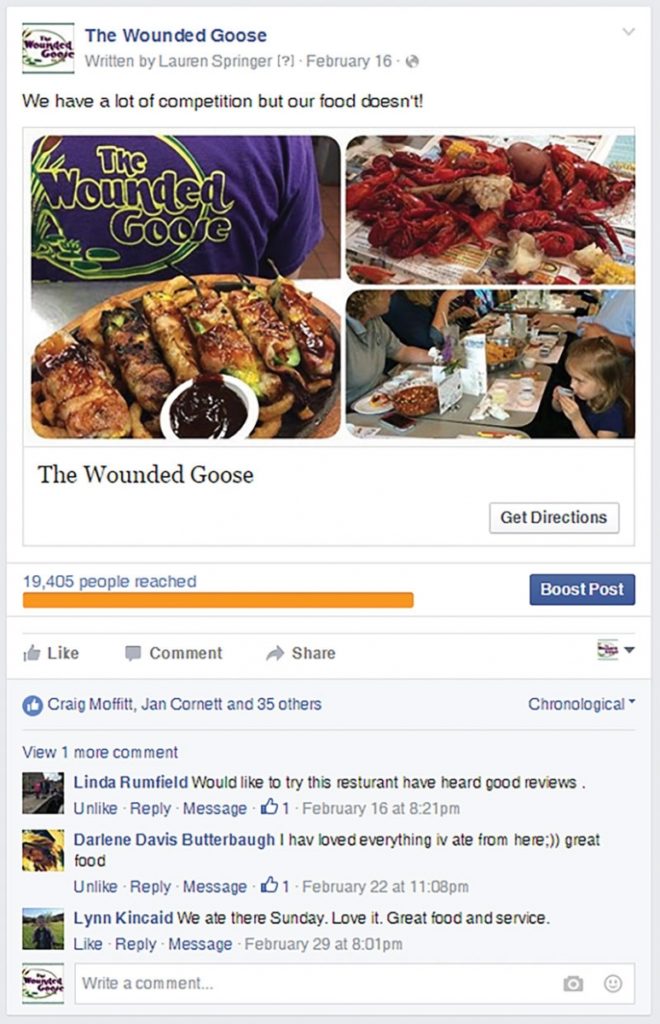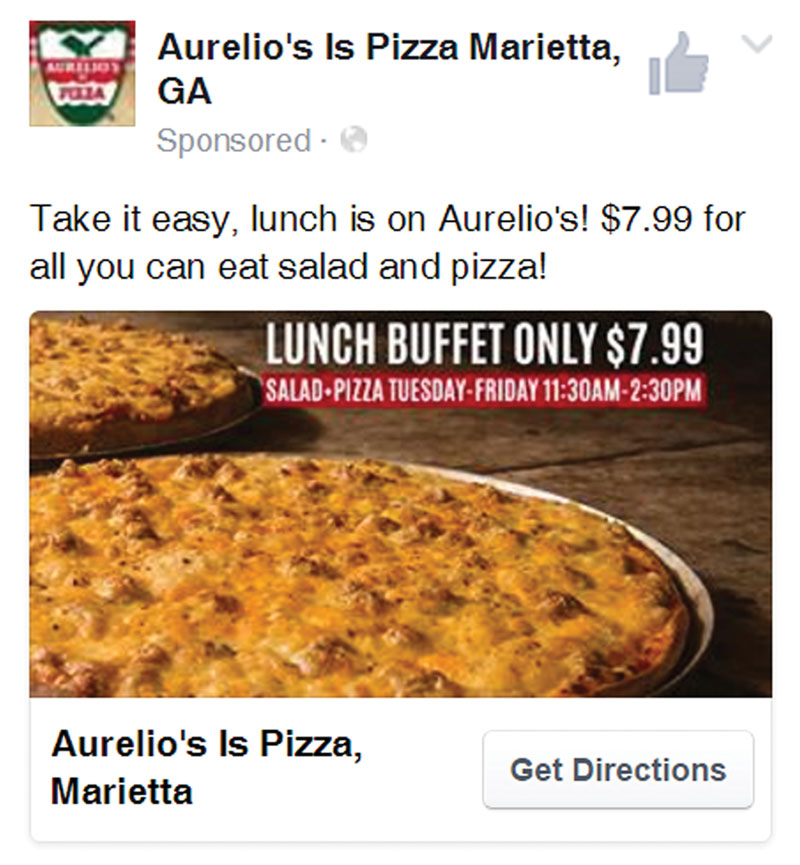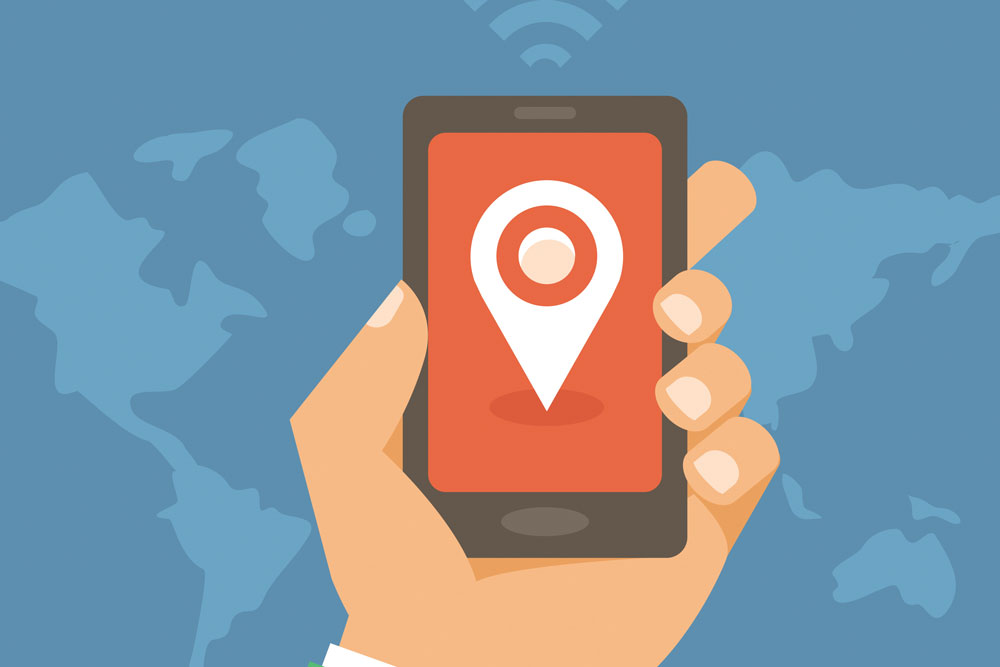 |
|
Facebook ads allow marketers to target potential customers based on their personal likes or purchasing behavior, including anyone who buys meals at other restaurants. |
Just when you think you have your time-tested marketing strategies down pat, from box toppers to e-newsletters, some newfangled option springs up to reach customers in today’s tech-savvy age. More pizzeria owners are now positioning their businesses in front of the customers they crave through geotargeting and geofencing, reaching them in their geographical area through online ads on high-traffic sites such as Google, Facebook and Twitter.
“You can put digital ads in front of the demographic you’re trying to reach, targeting only those people you want,” explains Nick Fosberg, owner of Bar Restaurant Success in Rockford, Illinois. “And it’s far cheaper than mass-media ads. With geotargeting, you can get 5,000 to 6,000 impressions for $6 to $7.” Sounds like a sweet deal, right? But it will take some effort, so we asked in-the-know experts for their top tips on how to make geotargeting pay optimal dividends.
Narrowing Down
Geotargeting starts with demographics: Who is your current customer, or whom do you want to target? “Most pizzeria owners may not have a statistical view of their typical guest, but they have an intuitive estimation—such as age, income and area,” says David Kincheloe, president of National Restaurant Consultants in Golden, Colorado. “With geotargeting, you can slice and dice data any way you want.”
Christa Vohs, digital marketing solutions director at Moving Targets in Perkasie, Pennsylvania, says Facebook has given pizzerias many ways to reach their ideal demographic through geographic targets. “In broad terms, you can target your ads by address, ZIP code, state or country, and from there you can use a custom radius with a distance of one to 50 miles outside of the address you’ve selected,” she explains. “On a more granular level, you can even exclude users in a certain area or ZIP code who are within the radius you’ve selected.”
In addition to location, Vohs notes, you can target ads by demographics (i.e., age or income), interests or behaviors. You can get very specific, particularly on Facebook, where your ads get posted directly into users’ news feeds, and you can easily set parameters: what times of day to run the ad, for example, or the daily budget you prefer, Kincheloe says.
| Getting On Google |
|
Outside social media platforms, Google AdWords offers another geotargeting option. Google AdWords can be used in two ways, notes Nick Fosberg, owner of Bar Restaurant Success in Rockford, Illinois. You can target a select group (for example, during football season, you might target males for a pizza-and-wings package), or target based on keywords like “pizza delivery.” “If you have a great offer and grab someone’s attention, Google AdWords can be very profitable,” Fosberg says. “But an ad with a logo and image isn’t going to do much. Even if they click on the ad, you have no clue where your customers are coming from or if they’re spending money with you.” Like with social media, make your offers trackable info-grabbers. David Kincheloe, president of National Restaurant Consultants in Golden, Colorado, notes that Google AdWords is ideal for operators who aren’t savvy about search engine optimization. But the cost depends on how many keywords you include and the ad’s placement. “If a person is searching something like ‘pizza near me,’ your ad pops up in the top two or three results or on the side of the page, depending on how much you pay,” Kincheloe explains. “You want to buy the words for anything you think your guest is going to type into a Google search.” However, Google AdWords proves a bit more complicated than the Facebook process, so you may need to get help from an expert. “You might find a local service to test out some Google ads with keywords or geotargeting,” Fosberg suggests. “Paying someone $20 an hour is well worth it—with a few hours for setup, that $100 will go a long way, rather than wrapping your head around all this technology stuff!” |
Fosberg adds that Facebook also allows for targeting people based on their personal “likes” or even their purchase behavior—for example, anyone who buys meals at other restaurants. “Facebook has teamed with the largest data compilers,” he says. “Anything you buy on your credit or debit card, Facebook marketers have access to. So you get a much higher ROI on your marketing dollars, because you’re not marketing to the masses, but to very specific people who are currently buying what you’re selling.”
A similar location-based approach, called geofencing, even allows you to create a virtual boundary around your pizzeria—for example, a one-mile radius or one city block—and target any customers who are in that geofenced area while, for example, shopping at a nearby mall or visiting a museum. “This type of advertising is more useful for attracting customers who may not always be in the area of the business in question,” Vohs says. Together, geotargeting and geofencing form a one-two knock-out punch for restaurant marketers, and, best of all, they’re typically inexpensive. “As most marketers know, there is no hard-and-fast rule for how much any advertising campaign will cost, but as a general rule of thumb, I recommend at least $50 for each campaign,” Vohs says. “Facebook’s local ads, which utilize geofencing, generally have a lower cost than ads with just geotargeting restrictions. We see an average cost of less than a penny for one single impression with local ads.”
Of course, the ultimate goal is for people to see your ad, then click on it so they reach your website or special offer—meaning that you must be hitting the right target. “Depending on the goal you have for each ad, you’ll need to tweak your desired interests or purchase behaviors,” Vohs says. “As a rule of thumb, I don’t recommend targeting more than five miles outside of a business, unless it’s in a rural location.”
Cashing In
After you’ve determined your target market, choose the offer that’s best designed to woo them. Moms might love a bundle deal that feeds the family, while college students may choose budget-minded options. At Fosberg’s restaurant/bars, he will offer an initial irresistible deal, such as a break-even offer or a loss leader. “A free medium pizza costs the owner $3 or $4, but when a person gives you his info to get it, he’s telling you he eats pizza,” Fosberg says. “Now you know these people want to do business with you.”
Hence, he adds, the most profitable way to handle these ads is to obtain key information from those who click. “Capture that person’s information—make an offer, then bring them to a one-page site for them to enter their name and email to get that specific offer,” Fosberg recommends. “Then create a list of those people; they’ll be the most profitable people to market to through email or Facebook ads.” Fosberg also ties geotargeted ad responders into his loyalty program—anytime someone opts in to the offer, that person automatically gets placed on the loyalty list to receive offers throughout the year.
You’ll also need to provide a great buying experience with a follow-up email (preferably with a personal message from the owner), then follow up again with a profitable offer (such as a package deal) in a week or two. “You send an email for free, and you could get a 10% or 15% response,” Fosberg says. “It’s the most profitable way to market your business.”
 |
|
Sponsored advertising on social media platforms reaches customers in your area for pennies. |
Tracking Response
Just as with any campaign, you’ll need to track your geotargeting results. “If you’ve decided to invest in social media advertising, you must set clear goals,” Vohs stresses. “If your goal is to increase in-store sales, then your initial reaction may be to run an offer ad. So you’ll want to measure not only the claims within the native platform, but how many people actually came into your business and redeemed the offer.” Vohs recommends setting aside time every month to check out the ad insights on Facebook or Twitter; if you didn’t reach your goals, adjust your targeting next month.
Kincheloe agrees that measuring results is a must. “Have the guest bring something to get the deal, just as with any print ad,” he recommends. “And make sure you have good analytics on the back end to see who’s looking at it.” Fosberg adds that you can lead customers to a printable page with the flier or coupon, or you can allow customers to show the ad on their phones for tracking purposes.
Finally, don’t rest on your laurels; experiment with different variations. “A lot of business owners don’t test different ads, which is really easy to do with digital marketing,” Fosberg notes. “Try a couple different headlines to find which works better, or try a different image or different offers.” If you hit on a winner, run it more frequently—and drop the poor performers. Do people respond better to a half-price pizza or 20% off the entire bill? What offer persuades people to click, and what actually gets them in the door? “Test something new for a day; you can test for a matter of 20 bucks, and you can stop it in a snap,” Fosberg says. “See what’s working and what’s not.” Then, he adds, take what works well online and use it offline—so if a 20%-off offer is working two times better than a half-off pizza, you’ll know the best offer to release in another format, like in a newspaper ad or direct mail. In other words, geotargeting can help you work smarter, not harder, even outside the tech bubble!















